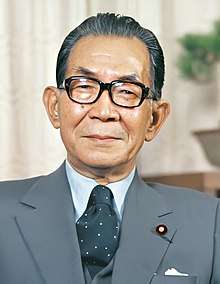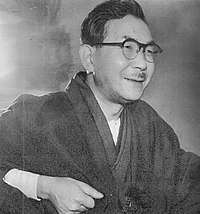Takeo Miki
Takeo Miki (三木 武夫, Miki Takeo, 17 March 1907 – 14 November 1988) was a Japanese politician who served as Prime Minister of Japan from 1974 until 1976.
Takeo Miki | |
|---|---|
三木 武夫 | |
 Takeo Miki | |
| Prime Minister of Japan | |
| In office 9 December 1974 – 24 December 1976 | |
| Monarch | Shōwa |
| Preceded by | Kakuei Tanaka |
| Succeeded by | Takeo Fukuda |
| Member of the House of Representatives | |
| In office 31 March 1937 – 14 November 1988 | |
| Constituency | Tokushima At-large |
| Personal details | |
| Born | 17 March 1907 Awa, Tokushima, Japan |
| Died | 14 November 1988 (aged 81) Tokyo, Japan |
| Political party | Liberal Democratic Party |
| Spouse(s) | Mutsuko Miki (1940–1988; his death) |
| Alma mater | Meiji University University of Southern California |
| Signature |  |
Background summary

Born in Awa, Tokushima, Miki graduated from Meiji University in Tokyo. He attended the University of Southern California in Los Angeles, and was awarded an honorary doctorate in law from the institution in 1966.[1]
Miki was elected to the Diet in 1937 and remained there until his death in 1988, during which he was elected a representative for 19 times over 51 years. In the 1942 general election he ran in opposition to the military government under Hideki Tojo and still managed to win a seat; his efforts at this time were assisted by Kan Abe, the grandfather of Prime Minister Shinzō Abe.[2]
Miki took over from Kakuei Tanaka as Prime Minister on 9 December 1974, following the latter's implication in the corruptions concerning real-estate and construction companies. Miki's attraction was particularly due his reputed political cleanness, and his weak power base from his small faction. In fact, he was not prepared to be prime minister at all, as was reflected when upon his election he murmured "a bolt from the blue".
During a visit by Miki to the funeral of Eisuke Sato in 1975, he was attacked by Hiroyoshi Fudeyasu, the secretary-general of the Great Japan Patriotic Party[3] with foreign dignitaries nearby.[4] This caused criticism of the Tokyo Metropolitan Police over not doing enough to ensure his safety.[3]
After being elected, Miki attempted to reform the LDP, relentlessly investigating the Lockheed bribery scandals, which made him a large number of enemies within the party. A campaign literally called "Down with Miki" ("Miki oroshi") was started by influential faction leaders. Despite Miki's personal popularity with the public, the Lockheed scandal reflected poorly on the party, which lost its overall majority in the 1976 election to the Diet and had to make deals with minor parties to remain in power. Embarrassed by the result, Miki resigned[5] and was succeeded on 24 December 1976, by Takeo Fukuda.
Miscellaneous
In Mao Zedong's final days, he took a great interest in Miki's political condition, as Miki was suffering a coup d'état from amongst his own party. Mao had never shown any interest in Miki before, or even mentioned him.
He held many other posts during his career in addition to being prime minister.
NFL player Takeo Spikes was named after Miki.[6]
Connection to Seattle
During his time in Seattle, Miki spent a period as a dishwasher at noted Japanese restaurant Maneki.[7]
To commemorate the ties of Japan to America, and Seattle in particular, Miki gave 1,000 cherry trees to Seattle to commemorate the United States Bicentennial in 1976. This gift gave birth to the Seattle Cherry Blossom Festival, still running annually.[8]
Slang Term
In Hong Kong, the name "Takeo Miki" (三木武夫) is sometimes used to describe actors or actresses with wooden or no emotional expressions during movies or TV dramas. Some have said that the origin for the slang term stems from Miki's wooden expression during his appearance in news reports.
Honours
- Grand Cordon of the Order of the Chrysanthemum (14 November 1988; posthumous)
Foreign honour
.svg.png)
Gallery
(1553489).pdf.jpg) Memorandum of Conversation, White House state dining room, June 30, 1976
Memorandum of Conversation, White House state dining room, June 30, 1976
References
- Japanese Minister of International Trade and Industry, Takeo Miki's visit to Los Angeles, California, 29–30 September 1966 and 1 and 3 October 1966, Japanese American National Museum, Accessed 10 February 2009.
- "Japanese prime minister`s another DNA". Dong-A Ilbo. 28 October 2013. Retrieved 15 January 2014.
- https://www.stripes.com/news/attack-on-miki-security-lapse-shock-citizens-1.20993
- https://www.nytimes.com/1975/06/17/archives/japanese-premier-is-punched-by-a-rightist-at-sato-funeral.htmlM
- "Tanaka reshuffles Japanese cabinet". Daytona Beach Morning. Tokyo. AP. 17 July 1974. Retrieved 6 January 2013.
- Michael Silver, Face Lift, Sports Illustrated, 26 November 2001, Accessed 7 October 2011.
- Broom, Jack (September 20, 2004), "Japanese eatery will serve up a centennial party of its own", The Seattle Times
- McKenzie, Madeline (April 24, 2019), "Enjoy a celebration of Japanese culture and other spring events in Seattle and Bellevue", The Seattle Times
| Wikimedia Commons has media related to Takeo Miki. |
This article incorporates text from OpenHistory.
| Party political offices | ||
|---|---|---|
| Preceded by Post established |
Secretary-General of the National Cooperative Party 1947 |
Succeeded by Seiichi Okada |
| Preceded by Nobusuke Kishi |
Secretary-General of the Liberal Democratic Party 1956-1957 |
Succeeded by Shōjiro Kawashima |
| Preceded by Toichirō Tsukada |
Chairman of the Policy Research Council, Liberal Democratic Party 1957-1958 |
Succeeded by Takeo Fukuda |
| Preceded by Okinori Kaya |
Chairman of the Policy Research Council, Liberal Democratic Party 1963-1964 |
Succeeded by Hideo Sutō |
| Preceded by Shigesaburō Maeo |
Secretary-General of the Liberal Democratic Party 1964-1965 |
Succeeded by Kakuei Tanaka |
| Preceded by Kakuei Tanaka |
President of the Liberal Democratic Party 1974-1976 |
Succeeded by Takeo Fukuda |
| Political offices | ||
| Preceded by Tetsu Katayama |
Minister of Communications 1947–1948 |
Succeeded by Eiji Tomiyoshi |
| Preceded by Mitsujiro Ishii |
Minister of Transport 1954–1955 |
Succeeded by Shinji Yoshino |
| Preceded by Ichiro Kono |
Director of the Economic Planning Agency 1958 |
Succeeded by Koichi Seko |
| Preceded by Shoriki Matsutaro |
Minister of State, Head of the Science and Technology Agency 1958 |
Succeeded by Tatsunosuke Takasaki |
| Preceded by Masanosuke Ikeda |
Minister of State, Head of the Science and Technology Agency 1961–1962 |
Succeeded by Tsuruyo Kondo |
| Preceded by Yoshio Sakurauchi |
Minister of International Trade and Industry 1965–1966 |
Succeeded by Watarō Kanno |
| Preceded by Etsusaburō Shiina |
Minister of Foreign Affairs 1966–1968 |
Succeeded by Kiichi Aichi |
| Preceded by Shuji Masutani |
Deputy Prime Minister of Japan 1972–1974 |
Succeeded by Takeo Fukuda |
| Preceded by Kakuei Tanaka |
Prime Minister of Japan 1974–1976 | |